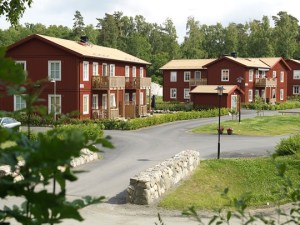By Erica Rascón on October 29, 2020 in Global
In the States, we’ve imported several great things from Sweden. Flat-pack furniture makes our rentals feel like home, and True Blood wouldn’t be the same without Alexander Skarsgård. But if you haven’t considered how Swedish imports could improve the quality and availability of subsidized housing, now is the time.
The value of inexpensive housing
Per a recent survey of 200 metros around the world, 90% of cities are considered “unaffordable.” Average housing prices are more than three-times  median incomes in most neighborhoods. In the U.S. alone, The Harvard Joint Center for Housing Studies reveals that 38.9 million households are cost-burdened, spending more than 30% of their income on housing.
median incomes in most neighborhoods. In the U.S. alone, The Harvard Joint Center for Housing Studies reveals that 38.9 million households are cost-burdened, spending more than 30% of their income on housing.
For low income households, affordable rentals are hard to obtain. In the U.S., there are roughly 36 available affordable units for every 100 extremely low-income renter households. The National Low Income Housing Coalition reports a shortage of 7 million affordable rentals. The National Multifamily Housing Council and National Apartment Association (NAA) express a need for a more conservative 4.6 million new units by 2030.
As city planners seek development and housing strategies that offer efficiency, quality and returns, they may find inspiration in Sweden. The BoKlok method could bridge the gap between what cities need, what cities can afford and what low-income renters can pay.
Affordable housing, Ikea style
BoKlok, a joint venture of Ikea and Swedish construction company Skanska, has successfully completed 11,000 homes throughout Sweden, Finland and Norway. The portfolio includes a senior housing collaboration with Queen Silvia of Sweden.
BoKlok brings the IKEA model to senior and affordable housing. The company keeps prices low by focusing on high volume and complete supply chain management: it controls land acquisition, product development and manufacturing. Large volumes and ample repetition facilitate fast turnarounds and low production costs. The venture also controls assembly at the sites, sales and marketing of the final product.
Additionally, prefab units make the most of high-cost, low availability metropolitan land. BoKlok can construct three times as many units on the same footprint as conventional development and construction.
Learn how to control costs, track budgets and improve profitability on your next affordable project.
Back in 2017, BoKlok experienced “great returns,” and has built upon that reputation. Expansion into the U.K. is scheduled for January 2021.
The expansion includes about 160 houses on a successful mixed-income housing model. About 30% would be allotted for public housing with the remainder on the BoKlok Left to Live income-based payment schedule. With Left to Live, residents pay about one-third of their income towards rent which is then funneled towards their 25-year mortgage.
Why cut-and-paste affordable housing strategies may (not) work in the U.S.
Income-based housing models have experienced success is in the U.S., and few include mortgage payment options. While both factors may bolster optimism, other factors pose barriers to entry for BoKlok and similar models.
In the U.S., the failure of affordable housing is closely tied to socio-economic and political challenges. NextCity, a nonprofit news organization promoting equitable cities, explains why affordable housing in the U.S. faces inherent barriers:
“When the U.S. government became active in the housing market in the 1930s, Congressional conservatives in alliance with the real estate industry ensured that the Wagner Public Housing Act of 1937 restricted public housing to the service of the poor living in already impoverished areas (ensuring a weak political base), tightly limited funding per unit, and gave local governments near complete control over whether to accept federal funds for housing, where to place the sites, and how to administer them. It is the straightjackets on public housing, paired with the intense residential segregation, that so badly disadvantaged these policies in the U.S.”
In terms of the aforementioned practices and policies, not enough has changed since the 1930s. Though BoKlok’s Ikea-style development, construction and sales process could notably cut costs and expedite the creation of subsidized units, there is little to address housing’s historic entanglements.
Additionally, experts explain that the lack of affordable housing development also stems from cost constraints, not the least of which includes rising land and materials costs. The venture’s land leasing process, which relies on donated and discounted land, is admirable yet difficult (at best) to scale.
Housing solutions may be more of a collage than a copy
There isn’t a single silver bullet for the affordable housing dilemma around the world. In the U.S., innovative thinkers in the industry make progress through a combination of efforts. From tiny homes as essential housing to unprecedented funding strategies, organizations fill demand through creativity and grit. BoKlok offers an additional way to address what cities need, what cities can afford and what low-income renters can pay.


